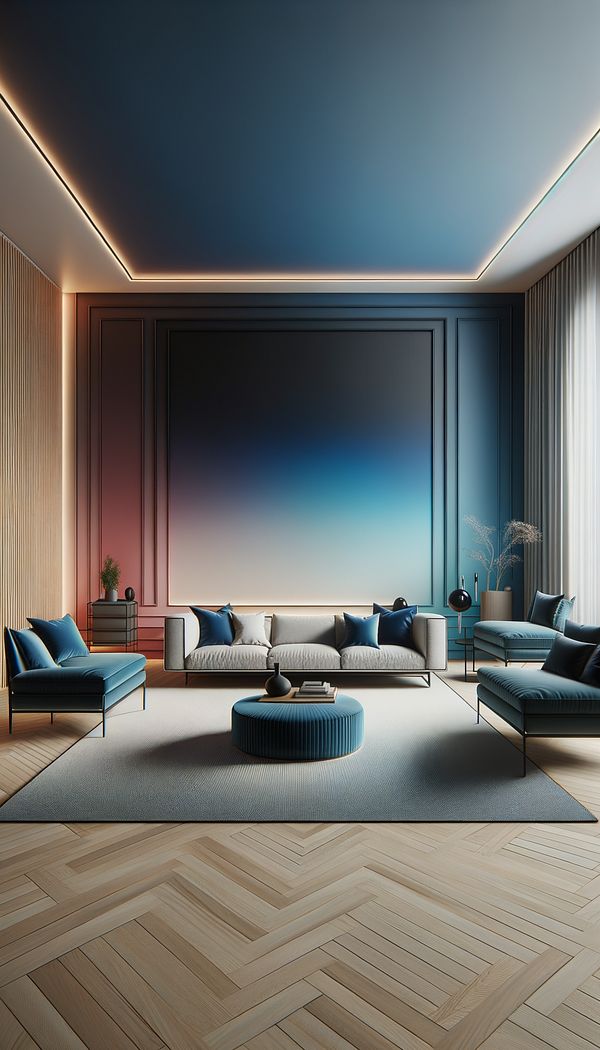What is a Gradient?
A gradient is a gradual transition of color or texture.
Description
A gradient in the context of interior design refers to the subtle and smooth transition between colors, textures, or both, across a surface or within a design element. This can be seen as a transition from one color to another, from one shade to a different intensity, or from a solid color to transparency, among other variations. Gradients can add depth, dimension, and a sense of movement to a design, making spaces appear more dynamic and visually interesting.
When applied thoughtfully, gradients can evoke emotions or create atmospheres within a space. For example, a gradient that transitions from dark to light shades can convey a sense of calmness and openness, while one that shifts from warm to cool tones might suggest energy and vibrancy. Gradients can be utilized in various elements of interior design, including wall treatments, textiles, flooring, and even lighting.
Correct application of gradients requires a good understanding of color theory and an eye for balance and harmony. When executed poorly, gradients can become overwhelming or clash with other elements within a space, disrupting the aesthetic and visual coherence of the design.
Usage
Gradients are commonly used in wallpaper designs, fabric prints, and decorative pieces, such as vases and lamps. They can also be incorporated into architectural elements, like glass walls or panels, where a gradient might transition from opaque to transparent, adding a layer of privacy while maintaining natural light. Even in lighting design, a skillful manipulation of light intensity can create a gradient effect, adding ambiance to a room.
FAQs
-
Can gradients be used in any style of interior design?
Yes, gradients can be adapted to fit various interior design styles. Their implementation can range from subtle and sophisticated in minimalistic designs to vibrant and bold in more eclectic spaces. The key is to match the gradient's color, intensity, and texture with the overall design theme.
-
Are gradients suitable for small spaces?
Absolutely. When used correctly, gradients can help to visually expand a small space, making it appear larger and more open. Light-colored gradients, in particular, can reflect more light and create a sense of airiness.
-
How can I incorporate gradients into my home without it feeling outdated?
To keep gradients feeling fresh and contemporary, focus on using modern color combinations and consider the context of their application. Incorporating gradients in accent pieces or textiles allows for easy updates in the future. Additionally, combining gradients with other on-trend elements can help ensure the design feels current.
Practical Application
When incorporating gradients into your design, start with a focal point and allow the gradient to guide the viewer's eye through the space. Consider the mood you want to evoke and choose your colors accordingly. Experiment with different scales of gradients; some might be bold and encompass large areas, while others might be more delicate, used as subtle accents. It's also important to balance the gradient with other solid or patterned elements in the room to create a cohesive look.
-
Decorative Techniques322 articles
-
Color & Patterns154 articles
-
Textiles & Upholstery252 articles
-
Wall Treatments & Finishes157 articles
-
ChenilleChenille is a soft, fuzzy fabric known for its luxurious texture.
-
TraditionalTraditional interior design is a timeless style that emphasizes classic, symmetrical arrangements and rich details.
-
OrgandyOrgandy is a lightweight, sheer, crisp fabric made from cotton or polyester.
-
Solid ColorsSolid colors refer to any color that lacks patterns, gradients, or any variegation.
-
ApronAn apron is a decorative or structural panel fixed beneath a surface such as a tabletop, window ledge, or countertop.
